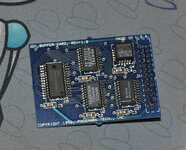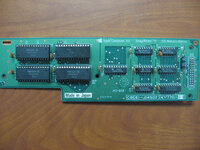sivolc73
Member
Hi, I'm currently using an old ImageWriter II on my machine to print small sized envelope, I find it very convenient since it doesn't have strict paper size limitation!
My problem is, mine doesn't have a buffer card, I use it via a serial adapter at very low baud rate to avoid filling the buffer...
Does any of you have schematic or even just high-resolution photos of the original buffer card? I know there is the Q-buff card, the ImageWare Orange Micro ImageBuffer and also the OEM apple 32k buffer card that exist, the original apple one is by far the simplest one and I would like to clone it.
The only photo I found of it is from the top only and a bit blurry so it doesn't help much with the retro-engineering...
So, if you got one and would like to share photos it would be greatly appreciated!
Thank you!
My problem is, mine doesn't have a buffer card, I use it via a serial adapter at very low baud rate to avoid filling the buffer...
Does any of you have schematic or even just high-resolution photos of the original buffer card? I know there is the Q-buff card, the ImageWare Orange Micro ImageBuffer and also the OEM apple 32k buffer card that exist, the original apple one is by far the simplest one and I would like to clone it.
The only photo I found of it is from the top only and a bit blurry so it doesn't help much with the retro-engineering...
So, if you got one and would like to share photos it would be greatly appreciated!
Thank you!


